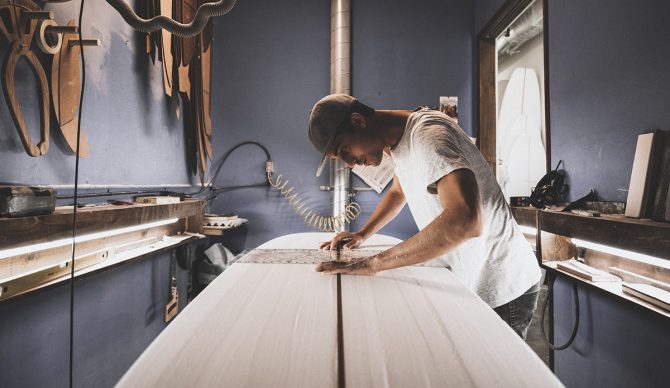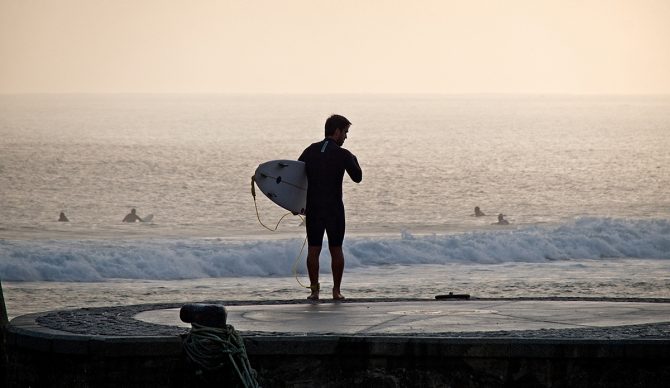
Ventura shaper Michael Arenal is wise beyond his years.
A recent Surfrider Foundation report on the “Recreational Profile of Surfers in the United States” puts the median age at 34, while a recently published study by the Australian Sports Commission states that, “…the average surfing participant no longer falls into the traditional definition of ‘youth’ (14-24),” but places the average age of an Aussie surfer between 45 and 49.
So what, you say? So I recently enjoyed a fine session at a remote California point break, sharing modest, three-to four-foot right walls with a small crew, all who could generously be described as “middle-aged.” One of our number, a very experienced surfer on the far side of 50, sat in the pack, sunk up to his clavicles on a tiny Sharp Eye thruster, patiently waiting his turn, when he would paddle for, and miss, virtually every wave that came his way.
“How big’s your board?” I asked, after watching another vain attempt to kick into a little swell.
“Five-seven,” he said, and proudly, too.
“Wow,” I said. “I bet it would work great in a hollow reef break.”
“Yeah,” he said. “I got it for a trip to Tavarua. It went great in six-to eight-foot Restaurants.”
But we weren’t surfing overhead Restaurants – we were surfing chest-high California point surf, where this guy’s board was definitely not working. Yet there he sat, missing wave after wave, only to be surprised when he finally did catch one and get the chance to push that little board down the line. I was thinking it, but an older surfer riding a contemporary longboard actually said it: “That guy needs a bigger board.”
You got that right. He and a lot of other surfers just like him, the remarkable number of older, yet still-competent, men and women seemingly determined to remain on contemporary “high performance” shortboards, while struggling not only to ride their waves effectively, but to even catch one in the first place. Not because of eroding skills or physical decline, but simply because their boards are too small.
Jeff Chamberlain, a vastly experienced Central Coast surf/photographer/explorer (and one of the guys out on the day described above) wrote this in a recent email to a similarly aged (read: currently collecting Social Security) friend contemplating a new board purchase:
“I’ve spent a lifetime watching too many of my friends ride boards that are just too short for their surfing, their age and their abilities. Always remember this fundamental fact: If you’re sitting, you’re not surfing, you’re just waiting. Anything you can do to increase your wave count should be your main priority, and nothing does that better than a longer board.”
Jeff’s is far from the first highly informed observation pointing to what might be considered a residual downside of the late 1960s “Shortboard Revolution.” Way back in a 1974 SURFER magazine interview, for example, renowned ’60s surfer/shaper/designer Phil Edwards was asked why he hadn’t fully embraced the shorter boards.
“Say what you want about the shortboard,” he said. “But on a longer board you just end up further down the beach. And isn’t that what it’s all about?”

What are you riding to ensure you reach the outer limits of fun? Photo: Miguel Amutio//Unsplash
Over a decade later, the late San Diego shaper/designer Mike Eaton, widely respected for shaping everything from teeny twin fins to 11-foot Waimea guns and everything in between, was asked about current surfboard trends during an interview with surf historian Matt Warshaw. Eaton flatly stated: “Eighty percent of all surfers should be riding eight-foot boards.”
This isn’t to suggest that everyone should ride a longboard (unless you choose to, of course), but neither is this state of surfing awareness limited to dusty archival interviews. Michael Arenal is a 31-year-old surfer today living and shaping in Ventura, California, who’s made his own observations on the idea of over-40 surfers riding sub-six foot surfboards. And considering that while only having been shaping for 14 years (that’s right, he started as a teenager in his parent’s garage) he just won the “Icons of Foam Shape-Off” at this year’s Boardroom Show, the kid’s worth listening to.
“The thing that brings us the most joy, no matter at what age or skill level, is catching waves and going fast enough to do some turns,” he says. “But though there are a select few who can maintain and even improve their skills as they get older, most surfers find themselves popping up a bit slower and not surfing as loosely as they did when they were younger. Not to mention having to compete against scrappy young surfers in the lineup. And surfing should be fun, not a lot of work. So for most surfers riding a board that does some of the work for you makes sense.”
And what, if you choose to ride a shortboard, is the sort of design that does that?
“For surfers who’ve grown used to shortboards and still want to ride that design as they get older, it means getting a larger board,” says Arenal. “Not that much longer, necessarily, although there are so many great mid-side options these days, but just scaled up in dimensions and volume. Proportionally scaled up, so you still get the same feeling, but can catch waves more easily. I mean, you gotta catch waves, right? You’re not surfing if you’re not catching waves.”
Sound familiar? But okay, so on the sensible scale, how up is up?
“I’d say that most averaged-sized, average skilled surfers should be riding boards in the mid-six-foot range,” Arenal suggests, who, though a lanky 6’2”, 170 pounds is a bit taller than average. Regardless, this talented young shaper-of-surfing’s-future recommends scaling up and stretching out board lengths to just about any surfer who wants to extend their stoke well beyond the “youth” stage.
“On a bigger board you’ll be catching more waves, finding it easier to surf, and having more fun,” he says. “And isn’t that kinda what it’s all about?”
Somewhere Phil Edwards is smiling.

